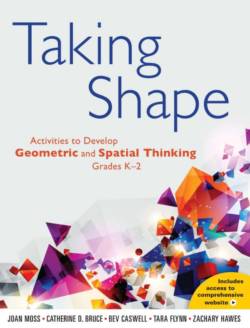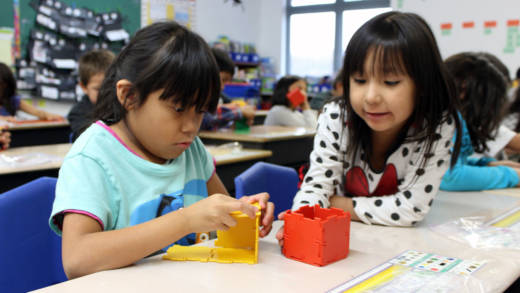Excerpted from "Taking Shape: Activities to Develop Geometric and Spatial Thinking" by Joan Moss, Catherine D. Bruce, Bev Caswell, Tara Flynn, and Zachary Hawes. Published by Pearson Canada Inc., 2016, pp. 13–16. Reprinted with permission by Pearson Canada Inc.
By Joan Moss, Catherine D. Bruce, Bev Caswell, Tara Flynn, and Zachary Hawes
Our journey began when we conducted an extensive literature review at the outset of the project (Bruce, Flynn, & Moss, 2012) and learned about the crucial importance of spatial reasoning. This theme was consistent across many research disciplines, including biology, cognitive sciences, psychology, developmental sciences, education, as well as educational neuroscience—an emerging transdisciplinary field which sits at the intersection of these other disciplines and aims for a collaborative approach in which educational theory and practice are informed by new findings in the cognitive sciences, and vice versa (Fisher, 2009). We also learned—and have experienced in our careers as mathematics educators and researchers—that spatial reasoning is a curiously unacknowledged and neglected area of the curriculum. During our involvement with the M4YC project, we have become more and more convinced of reasons why we should pay attention to spatial reasoning in early years mathematics. Below we offer our Top Five reasons why, as educators, we should care about spatial thinking when we plan, observe, and assess mathematics in our classrooms.
1. Spatial reasoning and mathematical thinking are intimately linked.
There are numerous research studies that demonstrate the relationship between spatial reasoning and what we typically think of as mathematical ability. For example, one research study found that the quality of block play at four years of age was a predictor of high school mathematics achievement (Wolfgang et al., 2001). Another study found a relationship between young children’s construction skills (such as playing with jigsaw puzzles and blocks) and strong number sense and success in solving mathematical word problems (Nath & Szücs, 2014). In fact, as Mix and Cheng (2012) report, “The relation between spatial ability and mathematics is so well established that it no longer makes sense to ask whether they are related” (p. 206). Researchers have underlined that the link between spatial reasoning and math is so strong that it is “almost as if they are one and the same thing” (Dehaene, 1997, p. 125). Reflecting on the strength of this relationship, others have noted that “spatial instruction will have a two-for-one effect” that yields benefits in mathematics as well as the spatial domain (Verdine, Golinkoff, Hirsh-Pasek, & Newcombe, 2013, p. 13). Of course, the practices of mathematicians also benefit from spatial reasoning; many mathematicians stress that their work relies strongly on visual and spatial representations and forms of understanding (Whiteley, Sinclair, & Davis, 2015).
 We can see how the various strands of mathematics are inherently spatial. Think about what happens when we compare the area of two polygons, such as a rhombus and a rectangle. To be successful, we can draw on spatial strategies such as composition and decomposition of 2D shapes, mental rotation, and visualization. In fact, research shows that spatial reasoning is linked to performance within many strands of mathematics including: basic magnitude and counting skills (Thompson, Nuerk, Moeller, & Cohen Kadosh, 2013), mental arithmetic (Kyttälä & Lehto, 2008), word problems (Hegarty & Kozhevnikov, 1999), algebra (Tolar, Lederberg, & Fletcher, 2009), calculus (Sorby, Casey, Veurink, & Dulaney, 2013), and advanced mathematics (Wei, Yuan, Chen, & Zhou, 2012).
We can see how the various strands of mathematics are inherently spatial. Think about what happens when we compare the area of two polygons, such as a rhombus and a rectangle. To be successful, we can draw on spatial strategies such as composition and decomposition of 2D shapes, mental rotation, and visualization. In fact, research shows that spatial reasoning is linked to performance within many strands of mathematics including: basic magnitude and counting skills (Thompson, Nuerk, Moeller, & Cohen Kadosh, 2013), mental arithmetic (Kyttälä & Lehto, 2008), word problems (Hegarty & Kozhevnikov, 1999), algebra (Tolar, Lederberg, & Fletcher, 2009), calculus (Sorby, Casey, Veurink, & Dulaney, 2013), and advanced mathematics (Wei, Yuan, Chen, & Zhou, 2012).
In one of the first studies of its kind to show specific links between spatial and mathematical skills, Cheng and Mix (2013) assessed children in both spatial and math skills. Children were randomly assigned to one of two groups: one group engaged in spatial training involving mental rotations, and the other group spent the equivalent amount of time working on crossword puzzles. Both groups of children completed pre- and post-tests involving a range of math and spatial skills. Children in the spatial training group outperformed those in the crossword puzzle group, demonstrating significant improvements in their calculation skills.


